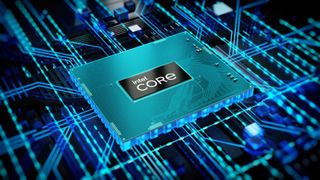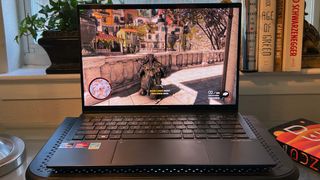14th-gen Intel chips could support ray tracing – and truly bring it to the masses
Integrated GPU with ray tracing support could appear next year

Intel Meteor Lake processors, the next-next-generation CPU from Intel due out in 2023, are expected to feature ray tracing support on a tiled-GPU architecture, marking a major step forward for the technology.
Ray tracing is a rendering process that lights up a rendered scene by mimicking the way we actually see light. This sounds almost silly (don't we see all light?), but making an artificial scene look natural requires calculating the intricate physics involved in how light behaves, and this is a genuinely daunting task from a computational perspective.
As it stands, ray tracing technology is currently only viable in gaming PCs with the best graphics cards or the best gaming laptops with discrete GPUs, making it a revolutionary technology that remains locked away in more "elite" applications on high-end hardware.
Intel's bringing the technology to its "integrated" Intel Xe graphics platform is a major advance in the technology that could make it far more accessible, however. We put integrated in quotes here since – as Wccftech points out – it's not quite the same thing as current-gen integrated graphics; it's actually a tiled architecture that's more like a system-on-a-chip than traditional integration into a single CPU die.
What matters though is that this is the kind of chip that will be going into standard laptops like ultrabooks or even the best Chromebooks that feature beefier specs like the one in our HP Elite Dragonfly Chromebook review.
Intel is already working on its own graphics upscaling tech to pair with its somewhat-beleagured Intel Arc desktop graphics cards, and that tech could easily make its way into Intel's 14th-gen processors. If so, it could make some of the best cheap laptops very capable 1080p gaming machines.
Could Intel Meteor Lake bring next-gen graphics to everyday users?

While we haven't even gotten our hands on Intel Raptor Lake chips yet – those are expected to launch as soon as October of this year – the first Intel Meteor Lake chips could land as soon as late 2023. If that's the case, you could be playing something like Cyberpunk 2077 with modest settings and some ray tracing on a base-spec Dell XPS 13 at a playable frame rate.
Get daily insight, inspiration and deals in your inbox
Get the hottest deals available in your inbox plus news, reviews, opinion, analysis and more from the TechRadar team.
This isn't to say that a single processor is going to turn even the best Ultrabooks into true gaming laptops. But with the advances in GPU technology that comes with something like ray tracing, it will have ancillary benefits for overall performance and – with proper settings tweaks (and upscaling technology) – you won't be restricted to playing light-duty or casual games like Civilization VI on a basic laptop.
As for desktops, this will be less of an advance, since most desktops have a free PCIe slot to slap in one of the best cheap graphics cards around capable of ray tracing, and these will run circles around the integrated graphics of even the best processors in Intel's 14th-gen lineup.
So this is mostly an issue for laptops, which is the fastest growing segment of the computer market by far. Traditional laptops have tended to be fairly light on gaming performance since this dramatically improves energy efficiency (i.e., battery life) and keeps costs down.
By integrating a ray-tracing GPU into the standard processor package for these laptops, we're going to see much more powerful performance across a whole range of graphics-intensive applications from video streaming to gaming at a much more affordable price point.
We've gotten a taste of this kind of performance already, and it is truly impressive

We already saw something similar in our Asus ZenBook S 13 OLED review, which is one of the first laptops to feature an AMD processor with integrated RDNA 2 graphics.
While the gaming performance wasn't mind-blowing in absolue terms, the fact that you could even run Port Royal on an Ultrabook is a major advance. Unfortunately, finding the ZenBook S 13 OLED is a frustrating challenge, something that wouldn't be the case with a laptop running Intel Meteor Lake.
While it will be some time yet before we see these laptops, it's good to know that they are coming, and it could offer consumers far more performance without having to make total sacrifices for affordability like they currently have to do. This can only be good for everyday consumers, whether you're a serious gamer or not.

John (He/Him) is the Components Editor here at TechRadar and he is also a programmer, gamer, activist, and Brooklyn College alum currently living in Brooklyn, NY.
Named by the CTA as a CES 2020 Media Trailblazer for his science and technology reporting, John specializes in all areas of computer science, including industry news, hardware reviews, PC gaming, as well as general science writing and the social impact of the tech industry.
You can find him online on Threads @johnloeffler.
Currently playing: Baldur's Gate 3 (just like everyone else).
